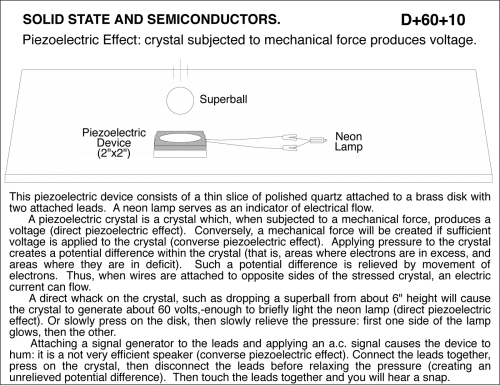Impact on piezo-electric device flashes neon bulb.
Primary tabs
Piezoelectric Effect: crystal subjected to mechanical force produces voltage. This piezoelectric device consists of a thin slice of polished quartz attached to a brass disk with two attached leads. A neon lamp serves as an indicator of electrical flow. A piezoelectric crystal is a crystal which, when subjected to a mechanical force, produces a voltage (direct piezoelectric effect). Conversely, a mechanical force will be created if sufficient voltage is applied to the crystal (converse piezoelectric effect). Applying pressure to the crystal creates a potential difference within the crystal (that is, areas where electrons are in excess, and areas where they are in deficit). Such a potential difference is relieved by movement of electrons. Thus, when wires are attached to opposite sides of the stressed crystal, an electric current can flow. A direct whack on the crystal, such as dropping a superball from about 6" height will cause the crystal to generate about 60 volts,-enough to briefly light the neon lamp (direct piezoelectric effect). Or slowly press on the disk, then slowly relieve the pressure: first one side of the lamp glows, then the other. Attaching a signal generator to the leads and applying an a.c. signal causes the device to hum: it is a not very efficient speaker (converse piezoelectric effect). Connect the leads together, press on the crystal, then disconnect the leads before relaxing the pressure (creating an unrelieved potential difference). Then touch the leads together and you will hear a snap.
UCB Index:
D+60+10
UCB Taxonomy:
Popularity:
- Log in to post comments

